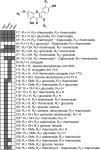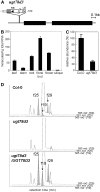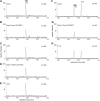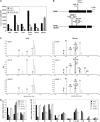Comprehensive flavonol profiling and transcriptome coexpression analysis leading to decoding gene-metabolite correlations in Arabidopsis
- PMID: 18757557
- PMCID: PMC2553606
- DOI: 10.1105/tpc.108.058040
Comprehensive flavonol profiling and transcriptome coexpression analysis leading to decoding gene-metabolite correlations in Arabidopsis
Abstract
To complete the metabolic map for an entire class of compounds, it is essential to identify gene-metabolite correlations of a metabolic pathway. We used liquid chromatography-mass spectrometry (LC-MS) to identify the flavonoids produced by Arabidopsis thaliana wild-type and flavonoid biosynthetic mutant lines. The structures of 15 newly identified and eight known flavonols were deduced by LC-MS profiling of these mutants. Candidate genes presumably involved in the flavonoid pathway were delimited by transcriptome coexpression network analysis using public databases, leading to the detailed analysis of two flavonoid pathway genes, UGT78D3 (At5g17030) and RHM1 (At1g78570). The levels of flavonol 3-O-arabinosides were reduced in ugt78d3 knockdown mutants, suggesting that UGT78D3 is a flavonol arabinosyltransferase. Recombinant UGT78D3 protein could convert quercetin to quercetin 3-O-arabinoside. The strict substrate specificity of UGT78D3 for flavonol aglycones and UDP-arabinose indicate that UGT78D3 is a flavonol arabinosyltransferase. A comparison of flavonol profile in RHM knockout mutants indicated that RHM1 plays a major role in supplying UDP-rhamnose for flavonol modification. The rate of flavonol 3-O-glycosylation is more affected than those of 7-O-glycosylation by the supply of UDP-rhamnose. The precise identification of flavonoids in conjunction with transcriptomics thus led to the identification of a gene function and a more complete understanding of a plant metabolic network.
Figures









Similar articles
-
Identification of a flavonol 7-O-rhamnosyltransferase gene determining flavonoid pattern in Arabidopsis by transcriptome coexpression analysis and reverse genetics.J Biol Chem. 2007 May 18;282(20):14932-41. doi: 10.1074/jbc.M611498200. Epub 2007 Feb 21. J Biol Chem. 2007. PMID: 17314094
-
Flavonol rhamnosylation indirectly modifies the cell wall defects of RHAMNOSE BIOSYNTHESIS1 mutants by altering rhamnose flux.Plant J. 2018 May;94(4):649-660. doi: 10.1111/tpj.13885. Epub 2018 Apr 6. Plant J. 2018. PMID: 29505161
-
The modified flavonol glycosylation profile in the Arabidopsis rol1 mutants results in alterations in plant growth and cell shape formation.Plant Cell. 2008 Jun;20(6):1470-81. doi: 10.1105/tpc.107.053249. Epub 2008 Jun 20. Plant Cell. 2008. PMID: 18567791 Free PMC article.
-
The flavonoid biosynthetic pathway in Arabidopsis: structural and genetic diversity.Plant Physiol Biochem. 2013 Nov;72:21-34. doi: 10.1016/j.plaphy.2013.02.001. Epub 2013 Feb 16. Plant Physiol Biochem. 2013. PMID: 23473981 Review.
-
Flavonols modulate plant development, signaling, and stress responses.Curr Opin Plant Biol. 2023 Apr;72:102350. doi: 10.1016/j.pbi.2023.102350. Epub 2023 Mar 2. Curr Opin Plant Biol. 2023. PMID: 36870100 Free PMC article. Review.
Cited by
-
Feedback inhibition of the general phenylpropanoid and flavonol biosynthetic pathways upon a compromised flavonol-3-O-glycosylation.J Exp Bot. 2012 Apr;63(7):2465-78. doi: 10.1093/jxb/err416. Epub 2012 Jan 16. J Exp Bot. 2012. PMID: 22249996 Free PMC article.
-
Quinolizidine alkaloid biosynthesis: recent advances and future prospects.Front Plant Sci. 2012 Oct 26;3:239. doi: 10.3389/fpls.2012.00239. eCollection 2012. Front Plant Sci. 2012. PMID: 23112802 Free PMC article.
-
A novel glucuronosyltransferase has an unprecedented ability to catalyse continuous two-step glucuronosylation of glycyrrhetinic acid to yield glycyrrhizin.New Phytol. 2016 Oct;212(1):123-35. doi: 10.1111/nph.14039. Epub 2016 Jun 2. New Phytol. 2016. PMID: 27252088 Free PMC article.
-
Use of the growing environment as a source of variation to identify the quantitative trait transcripts and modules of co-expressed genes that determine chlorogenic acid accumulation.Plant Cell Environ. 2010 Jul;33(7):1220-33. doi: 10.1111/j.1365-3040.2010.02141.x. Epub 2010 Mar 1. Plant Cell Environ. 2010. PMID: 20199615 Free PMC article.
-
Cellulose assembles into helical bundles of uniform handedness in cell walls with abnormal pectin composition.Plant J. 2023 Nov;116(3):855-870. doi: 10.1111/tpj.16414. Epub 2023 Aug 7. Plant J. 2023. PMID: 37548081 Free PMC article.
References
-
- Akiyama, K., Chikayama, E., Yuasa, H., Shimada, Y., Tohge, T., Shinozaki, K., Hirai, M.Y., Sakurai, T., Kikuchi, J., and Saito, K. (2008). PRIMe: A Web site that assembles tools for metabolomics and transcriptomics. In Silico Biol. 8 0027. - PubMed
-
- Andersen, Ø.M., and Markham, K.R. (2006). Flavonoids: Chemistry, Biochemistry, and Applications. (Boca Raton, FL: CRC Taylor & Francis).
-
- Aoki, K., Ogata, Y., and Shibata, D. (2007). Approaches for extracting practical information from gene co-expression networks in plant biology. Plant Cell Physiol. 48 381–390. - PubMed
-
- Bloor, S.J., and Abrahams, S. (2002). The structure of the major anthocyanin in Arabidopsis thaliana. Phytochemistry 59 343–346. - PubMed
Publication types
MeSH terms
Substances
LinkOut - more resources
Full Text Sources
Other Literature Sources
Molecular Biology Databases
Research Materials

